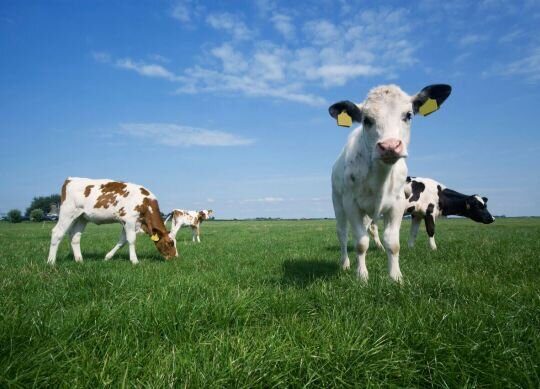‘Are they big enough?’: Monitoring dairy heifer growth and development
Just as more is less, bigger is not always better when it comes to the growth and development of dairy heifers. The nature and growth of dairy cattle has vastly changed from decade to decade, and as traits have been genomically bred out of cattle, often the idea of “bigger equals better,” has become a misjudged trend.
During a Dairy Heifer Growth and Development webinar hosted by Penn State, Jud Heinrichs (professor of dairy nutrition at Penn State), Cassie Yost (an extension educator in Franklin County, Pennsylvania) and Carly Becker (an extension educator in Franklin County, Pennsylvania) discussed the proper growth rates for dairy heifers using data correlating to future milk yields, as well as different measurement tools and scoring systems to help farmers keep track of this development.
Depending on the heifer’s age, a slower or faster growth rate can affect mammary development differently, Heinrichs said. As a calf, most of the animal’s bodyweight is made up of muscle. During puberty age, her growth will consist more of fat. The mammary gland grows at a parallel rate with the heifer, and as she matures, much of the challenge lies in finding a growth rate that is conducive to an ideal milk yield once she starts lactating, he said.
Weaning to puberty
Studies show there is a significant difference in milk production yields when comparing grain to milk. With an average daily gain of 0.2 pound from milk replacer, Heinrichs saw an additional 19% in milk production once they started lactating, in comparison to grain, which resulted in an 81% increase in milk production. In most circumstances, Holsteins should never gain more than 1.8 pounds per day before puberty. Jerseys, on the other hand, should not gain more than 1.2 pounds per day before puberty. Going beyond those numbers means there is a greater potential for a loss of milk production in the future, he said.
He also provided an example of the recommended average daily gain from weaning to puberty using a 1,540-pound mature Holstein:
- Birthweight = 85 pounds
- 8-week weight = 165 – 175 pounds
- Weaning to 4 months = 429 – 484 pounds (1.8 pounds per day)
- 4 – 9 months = 700 – 754 pounds (50% mature bodyweight)
- 9 – 22 months = 1,220 pounds (1.2 pounds per day)
Puberty to calving
Usually at nine months old, heifers will reach puberty and experience their first cycle. Their bodyweight will likely be at 50%. Heinrichs recommended for them to be bred at 55% mature bodyweight because he has found they are reproductively more efficient if they go through a few cycles before being bred. Before calving, the heifer should be at 71%-77% mature bodyweight. Heinrichs explained that in a 2020 study, they found that 81% of mature bodyweight is the most optimal percentage for average 305-days-in-milk yield. However, as the animal’s bodyweight nears 81%, culling risk also increases earlier in life.
Monitoring weight
To keep up with calf and heifer growth rates, scales and height measurement tools are the best options to monitor these numbers, Yost said. For many facilities, calf carts, portable scales and squeeze shoots are helpful instruments available to farmers. However, some farms may not have the proper resources for these devices, so heifer weight tapes are a universal tool that can be used for all breeds and for a variety of ages, she said. The tape has measurements small enough for young calves and large enough for mature heifers, and numbers come in both pounds and kilograms. When using this tool, Yost suggested setting the tape behind the animal’s shoulders and pulling it close to line up the numbers.
Additionally, skeletal growth has a correlation to milk production, Heinrichs said. A study conducted in 2016 by Iowa State University and Penn State shows that taller and medium-height heifers have better first-lactation milk yields. Height can be measured using height sticks, which are available for purchase or can be easily made. However, as heifers get older, using these tools can become more difficult, so the use of headlocks is encouraged, Yost said. Another way to measure height with older animals is attaching a measuring tape to a post near the headlocks. As the heifers walk past to eat or enter into the exercise pen, a measurement of their height can be quickly and easily gathered, Yost said.
Body condition scoring
Body condition scoring is a helpful mechanism used to help farmers access what is keeping their animals from reaching their key performance measures, Becker said. The scoring is done using a 5-point system, which increases and decreases in increments of 0.25. While the assessment is subjective, it is a good way to analyze fat reserves of older heifers and cows, especially during the pre-breeding period. During this age, body scores are crucial because under- and over-conditioned heifers will see a large impact in fertility, she added. Becker said the main areas to target when observing are the hooks and pins, thurls, short ribs, tailhead ligament and sacral ligament. According to Penn State Extension, ideal scores according to age are as follows:
- Pre-breeding (10-12 months): 2.75
- Breeding (12-15 months): 3
- Bred (15-20 months): 3.25
- Calving (greater than 20 months): 3.5
From an economic standpoint, making sure your heifers are growing at an appropriate rate will not only help you save fiscally, but it also sets things up for success once that animal starts producing milk and becomes an addition to the herd. To aid in this, Penn State has designed a resource that creates your own heifer growth chart (CLICK HERE), customizable to your farm.
Adapted from Adriana Toste for Progressive Dairy.



